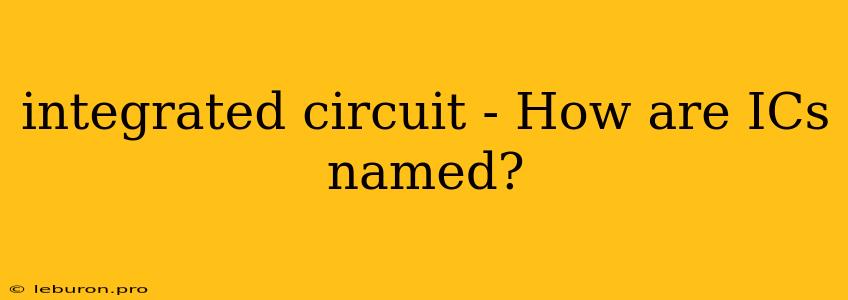Integrated circuits (ICs), also known as microchips or semiconductors, are the heart of modern electronics. From smartphones and computers to cars and medical devices, ICs power our world. But have you ever wondered how these tiny marvels are named? While the names themselves might seem arbitrary, there's actually a method to the madness. This article will delve into the fascinating world of IC naming conventions, exploring the key elements that define these vital components.
The Building Blocks of IC Names
IC names are not random strings of letters and numbers. They are carefully crafted to convey essential information about the chip, providing insights into its function, manufacturer, and even its specific features. Let's break down the common elements you might encounter in an IC name:
1. Manufacturer Prefix
The first part of an IC name often identifies the manufacturer. This prefix helps engineers and technicians quickly determine who produced the chip. For example:
- Intel: Intel's processors often start with "Intel" followed by a series of numbers and letters (e.g., Intel Core i7-12700K).
- Qualcomm: Qualcomm's Snapdragon chipsets commonly begin with "Snapdragon" (e.g., Snapdragon 8 Gen 2).
- Texas Instruments: TI, a leading semiconductor manufacturer, frequently uses "TI" as part of its IC names (e.g., TI MSP430).
2. Product Family
The next part of the name often designates the product family or series to which the IC belongs. This helps categorize chips with similar functionalities or architectures. Examples include:
- Core i Series: Intel's Core i series encompasses a range of processors designed for desktops and laptops.
- Snapdragon 8 Series: Qualcomm's Snapdragon 8 series includes flagship mobile processors known for their high performance.
- MSP430 Series: Texas Instruments' MSP430 series comprises low-power microcontrollers.
3. Specific Model Number
Within a product family, each IC has a specific model number. These numbers provide even finer details about the chip's capabilities, such as core count, clock speed, and features. For instance:
- i7-12700K: This Intel processor model signifies a 12th Generation Core i7 chip with 12 cores.
- Snapdragon 8 Gen 2: This Qualcomm chipset belongs to the Snapdragon 8 series and represents the second generation of the series.
- MSP430F5529: This TI microcontroller belongs to the MSP430 family and features a specific set of functionalities.
4. Packaging and Other Identifiers
The final part of an IC name may contain information about its packaging type (e.g., QFP, BGA) or specific features. These details are crucial for engineers designing and assembling electronic systems.
Naming Conventions for Different IC Types
While the general principles remain consistent, specific naming conventions may differ across various types of integrated circuits. Here are some examples:
1. Microprocessors
- Intel: Intel's processors are known for their alphanumeric names, often starting with "Intel Core," followed by the generation number (e.g., 12th Gen), and a specific model number (e.g., i7-12700K).
- AMD: AMD's processors also feature alphanumeric names, often starting with "AMD Ryzen," followed by the generation number (e.g., 7000 Series), and a specific model number (e.g., Ryzen 7 7700X).
2. Microcontrollers
- Microchip Technology: Microchip's microcontrollers frequently use a combination of letters and numbers. For example, the PIC microcontroller family uses names like PIC16F887.
- Atmel (Now Part of Microchip): Atmel microcontrollers, now part of Microchip, often have names starting with "AT," followed by a series of numbers and letters (e.g., ATmega328P).
3. Memory Chips
- Samsung: Samsung's DRAM memory chips often use names starting with "K4," followed by letters and numbers that denote capacity, speed, and other characteristics (e.g., K4A4G165WB-BCK0).
- Micron: Micron's DRAM memory chips often use similar naming conventions to Samsung, starting with "MT," followed by letters and numbers that specify the memory type, size, and speed (e.g., MT41K128M16JT-125).
Why Naming Conventions Matter
IC naming conventions serve multiple critical purposes:
- Identification: Clear and consistent names allow engineers to quickly identify and differentiate different types of ICs.
- Compatibility: Naming conventions can help ensure that components from different manufacturers are compatible within a system.
- Documentation and Support: Standardized names simplify documentation and technical support, making it easier for engineers to find information and troubleshoot problems.
- Marketing and Branding: IC names can be used to convey information about a chip's performance, features, and target market.
The Evolution of IC Names
As the complexity of ICs has grown, so have the naming conventions. Early ICs might have had simple, generic names. But with advancements in technology and the rise of specialized applications, naming schemes have become more intricate. For example, the use of generation numbers (e.g., 12th Gen Core i7) or specific feature identifiers (e.g., "X" for an unlocked processor) is a testament to the evolution of IC naming conventions.
The Future of IC Naming
With the continued growth and innovation in the semiconductor industry, we can expect further evolution in IC naming conventions. New technologies like artificial intelligence, machine learning, and quantum computing will likely influence the way we name and categorize these advanced chips. However, the fundamental principles of clear identification, compatibility, and documentation will remain essential.
Conclusion
The world of integrated circuits is a complex and fascinating realm. Understanding how ICs are named can provide valuable insights into their capabilities, origins, and applications. Whether you are a seasoned engineer or just starting your journey in electronics, knowing the language of IC names will help you navigate the intricate world of semiconductors with confidence.
